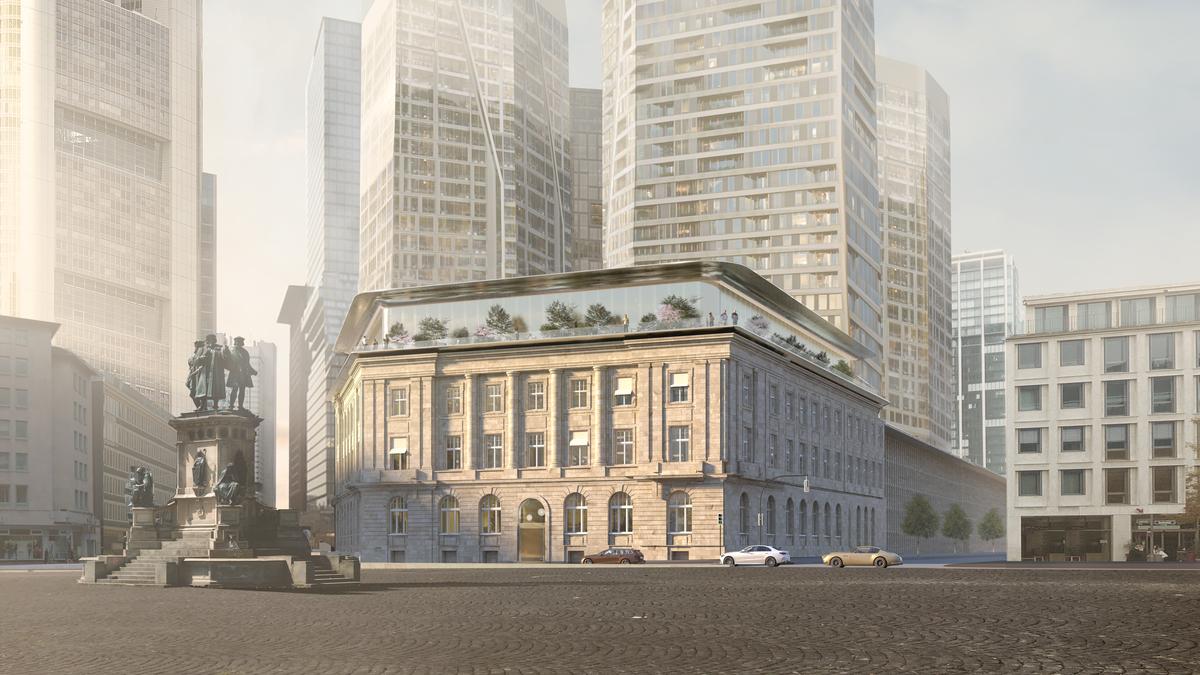PALAIS AM ROSSMARKT: ABG Real Estate Group and HanseMerkur Grundvermögen AG announce comprehensive revitalisation plans
• Heritage-compliant renovation and redesign of a historic Frankfurt landmark in a prime location between the banking district and Hauptwache
• Total investment volume of over EUR 250 million
• Construction scheduled to begin in 2026, with completion planned for 2029
• Sustainable concept targeting LEED Platinum, WiredScore Gold and WELL Gold certifications
Frankfurt/Hamburg, 7 March 2025 – ABG Real Estate Group and HanseMerkur Grundvermögen have presented their plans for the revitalisation of the listed PALAIS AM ROSSMARKT. Situated in the centre of Frankfurt, the historic building is to be refurbished in line with the requirements of the City of Frankfurt and the State Office for the Preservation of Monuments of Hesse. The property will be transformed into a contemporary office and commercial building, offering high-quality outdoor spaces and aiming to meet the highest sustainability standards. The total investment amounts to over EUR 250 million.
The listed natural stone façade will be preserved and carefully restored. The attic floor, dating from the 1960s, is to be removed and replaced by a recessed glass rooftop structure with a surrounding green terrace. The historic Frankfurter Saal and the characteristic staircase will be restored to their original form. A newly designed inner courtyard will provide additional recreational space in the city centre, offering a distinctive working environment with ample natural light. Plans for the PALAIS AM ROSSMARKT also include modern shared workspaces and a café with outdoor seating on Triangelplatz. One of the project’s highlights will be a landscaped rooftop garden of more than 1,500 sqm, creating a unique green space in the heart of the city.
Offering over 15,800 sqm of lettable space, the building will provide flexible office accommodation with spacious floorplates, generous ceiling heights and adaptable layouts. Equipped with advanced digital infrastructure and smart building technology, the property is designed to meet the demands of future workplaces. The project aspires to set new benchmarks in sustainability and is targeting LEED Platinum, WELL Gold and WiredScore Gold certifications. Energy will be supplied via high-efficiency heat pumps, supported by a photovoltaic system. The green rooftop garden will help improve the microclimate and mitigate heat during the summer months. Intelligent heating and cooling systems are also expected to contribute to reducing CO₂ emissions.
The architectural design is being led by Volker Staab, a leading German architect specialising in historic buildings. His portfolio includes the Jewish Museum Frankfurt, Casals Forum Kronberg, the Ministry of the Interior in Stuttgart and the House of the Wannsee Conference in Berlin. Both the City of Frankfurt and the State Office for the Preservation of Monuments of Hesse have responded positively to the concept and are closely involved in its development. The building permit application is scheduled for the second half of 2025, with construction due to start in 2026 and completion anticipated in 2029.
Ulrich Höller, Managing Partner of ABG Real Estate Group, commented: "The PALAIS AM ROSSMARKT” is one of the most architecturally significant properties in Frankfurt’s city centre. Once again, we are taking on the special task of carefully and at the same time forward-looking revitalising this iconic building for Frankfurt. This project stands for our commitment to bringing history and modernity into harmony while also setting the highest sustainability standards."
Malte Andes, Deputy Chairman of HanseMerkur Grundvermögen AG, added: "With Palais am Rossmarkt, we are once again making a clear contribution to the development of Frankfurt’s city centre, following our work on Central Parx. Both properties combine excellent locations with state-of-the-art facilities, reflecting the premium strategy of HanseMerkur Grundvermögen."
Marcus Gwechenberger, Head of Planning and Housing for the City of Frankfurt, said: "The revitalisation of this listed building supports the ongoing enhancement and accessibility of the Rossmarkt district and continues the positive trend we have seen in other projects across the city centre. Features such as shared workspaces, a café with outdoor seating and a publicly accessible rooftop garden contribute to our vision of a lively and welcoming urban environment."
About PALAIS AM ROSSMARKT
ABG Real Estate Group and HanseMerkur Grundvermögen AG acquired the building in 2022 from a PGIM Real Estate fund.
Constructed in 1903/1904 as a prestigious bank building for the Disconto-Gesellschaft, one of Germany’s leading banking institutions at the time, the building later served as Deutsche Bank’s Frankfurt branch for over 90 years, and for a period as its main headquarters. At the time of completion, it was the largest building on Rossmarkt, designed in the Louis XVI style. Its light sandstone façade, sourced from Franconia and Silesia, and the richly decorated interior spaces were inspired by elements of late Baroque and early Neoclassicism. The staircase design was modelled on that of the Würzburg Residence. The architects Eugen Rückgauer and Hermann Ritter were responsible for the design. Rückgauer also designed the Kunstpalast Düsseldorf (now the Ehrenhof), while Ritter contributed to the representative buildings of the Baghdad Railway, including the Haidar-Pasha Station in Istanbul. Construction was carried out by the Frankfurt-based company Philipp Holzmann, which was also involved in the construction of the Baghdad Railway. The building has undergone several extensions and modifications over time. Following extensive damage in 1944, it was rebuilt, with some alterations to the façade and internal layout. Today, the property is listed as a cultural monument by the City of Frankfurt. With its wood-panelled Frankfurter Saal, once used for board meetings, and the President’s Office, from which Deutsche Bank’s former CEO Hermann Josef Abs managed the bank’s operations, it remains a unique example of German banking history and one of the few neoclassical-style buildings still standing in Frankfurt’s city centre.

